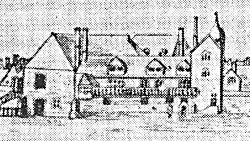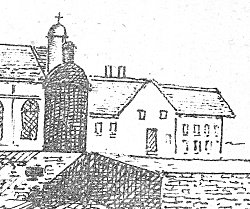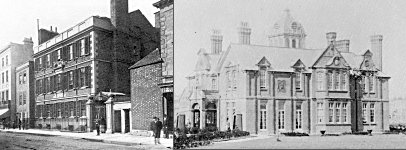
On 2nd June 1540, John Incent, Master of the Hospital of St. Nicholas signed the Deed of Surrender that handed the hospital over to the crown, thus ending over 300 years of service to the poor and sick in Portsmouth. From this time onwards, the Domus Dei (now the Royal Garrison Church), together with it's complex of surrounding buildings, became the miltary centre of the town. As was befitting this new role the Domus Dei also became the residence of the 'Captayne', or Governor of Portsmouth.
In 1561 Queen Elizabeth I visited Portsmouth and resolved to use her great power to develop and fortify the town. She would pay for this by creating the first State Lottery in 1569 which consisted of the issue of 400,000 10 shilling tickets with a first prize of £5000. The work on strengthening the town, including the improvement of the Governor's Quarters, went on for over 20 years during which time the role of the Governor, Sir Adrian Poynings (1559-71) and Sir Henry Radclyfe (1571-93) grew in importance. The first stage of the process by which the Governor's residence was enhanced appears to have been a modernisation of the existing buildings. Evidence for this is found in the Lansdowne MSS where there are two estimates dated 1581 and 1582 which were for "converting God's House and other buildings into a residence for the Governor" [HP Wright]. At some later date however it was decided that an entirely new building was required.


The house occupied an area to the south-east of the chancel and was built so as to incorporate the Domus Dei as a private chapel. Although the construction of this building would have entailed the demolition of parts of the original Domus Dei, other parts, such as the stables were incorporated into the new residence. Early references to this complex describe how the residents of the Governor's House had direct access to a gallery over the southern side of the chancel and although there is still a door there at ground level it is difficult to envisage how a gallery might have been constructed.
There are numerous extant drawings of the Governor's House (and Domus Dei), the earliest known being from around the time of Charles II. The drawings were possibly made to commemorate the marriage of King Charles II and Catherine of Braganza which took place there in 1662. Some historical records place the marriage ceremony in the chancel of the Domus Dei but it was far too small for a royal wedding. The wedding actually took place in the Presence Chamber in the Governor's House. Lady Fanshawe, the wife of Sir Richard Fanshawe, the ambassador who had negotiated the marriage, says in her memoirs that "... the King married the Queen...in the Presence Chamber of His Majesty's House. There was a rail across the upper part of the room, in which entered only the King and Queen, the Bishop of London (Dr. Gilbert Sheldon), the Marquis Desande, the Portuguese Ambassador and my husband; in the other part of the room there were many of the nobility and servants to their majesties."
The Governor's House continued to play host to the monarch and his family, beginning in 1672 when the Duke of York (the future King James II) paid a visit, having passed through the streets of Portsmouth lined with 3000 troops. Records also refer to a visit by Queen Anne, when she presented a selection of Communion silver plate to the church, though the date is unclear. The next royal visit did not take place until 2nd May 1778 when George III and Queen Charlotte arrived in Portsmouth. They came again in 1794 to do honour to the great Admiral Lord Howe following the Battle of the Glorious First of June.

If the drawings we have of Government House are accurate then the building must have been remodelled on a number of occasions in the 18C/19C. According to William Gates in "The Portsmouth That Has Passed" the house, in it's final incarnation, contained 43 apartments and had walls 3'9" thick. Despite this knowledge though, Gates made no comment about the apparent incongruity of the south-east and south-west elevations. What is not in doubt is that in 1814 the house played host to one of the most glittering events in the history of the town. To celebrate the banishment of Napolean, the Prince Regent assembled a prestigious group of European royalty, statesmen, politicians and military leaders who met at Government House. The event was recorded by many historians, one of which was the young Lake Allen, whose account can be read in our Events Section.
This however was the last event of its type to be played out at Government House, as by 1826 the house had been demolished.

After 1826, the ground where the house had stood was levelled and converted into a parade ground and in this state it remained until the area was turfed after WW2. The foundations of the house therefore have not been disturbed for nearly 200 years despite keen archaeological interest. The area is now divided between English Heritage who have responsibility for the land south of the Garrison Church, whilst the Ministry of Defence own the land to the east. No resources are currently available to enable excavation of the site, but in 2008 the Friends of the Garrison Church were offered the services of a dowser who located some of the main foundations.
Government House in 19C/20C
In 1826 the Governor of Portsmouth may have lost his original residence but the need for one remained. The Governor then moved temporarily to a house in St Thomas Street before the War Office bought Admiralty House, the Naval Commander-in-Chief's house at 111 High Street. This building is known to have originally been the residence of Philip Varlo, four times Mayor of Portsmouth between 1764 and 1776. The last Lieutenant-Governor to occupy the house was Prince Edward of Saxe-Weimar (1878-1884)

In 1882 a new Government House was built on what is now Ravelin Park. There successive Lieutenant-Governors and Garrison Commanders were based (the post of Governor having been abolished in 1834). Perhaps the most famous of the Commanders was Brigadier Bernard (Monty) Montgomery who held the post in 1937 but even he could do nothing to prevent the house being bombed in WW2 after which it was finally demolished. As the post of Garrison Commander had now been superceded by a Senior Army Officer there was no longer a requirement for a Government House. The site in Ravelin Park is now part of the University of Portsmouth.
There is a list of The Governors and Lieutenant-Governors of Portsmouth (1290-1968) in our People section.
Postscript
In May 2009, the Time Team carried out an archaeological evaluation at the site of the Domus Dei and were able to confirm that at least part of the original building was re-used in the construction of the Governor's residence. There is a provisional report into the excavation on the Time Team page on this site.